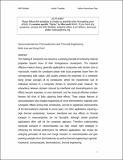Nanocomposites for thermoelectrics and thermal engineering
Author(s)
Liao, Bolin; Chen, Gang
DownloadNanocomposites_for_TE_and_thermal_v7_final.pdf (1.028Mb)
OPEN_ACCESS_POLICY
Open Access Policy
Creative Commons Attribution-Noncommercial-Share Alike
Terms of use
Metadata
Show full item recordAbstract
The making of composites has served as a working principle of achieving material properties beyond those of their homogeneous counterparts. The classical effective-medium theory models the constituent phases with local properties drawn from the corresponding bulk values, whose applicability becomes questionable when the characteristic size of individual domains in a composite shrinks to nanometer scale, and the interactions between domains induced by interfacial and size effects become important or even dominant. These unique features of nanocomposites have enabled engineering of extraordinary thermoelectric materials with synergistic effects among their constituents in recent years. For other applications requiring high thermal conductivity, however, interfacial and size effects on thermal transport in nanocomposites are not favorable, although certain practical applications often call for the composite approach. Therefore, understanding nanoscale transport in nanocomposites can help determine appropriate strategies for enhancing the thermal performance for different applications. We review the emerging principles of heat and charge transport in nanocomposites and provide working examples from both thermoelectrics and general thermal engineering.
Date issued
2015-09Department
Massachusetts Institute of Technology. Department of Mechanical EngineeringJournal
MRS Bulletin
Publisher
Cambridge University Press (Materials Research Society)
Citation
Liao, Bolin, and Gang Chen. “Nanocomposites for Thermoelectrics and Thermal Engineering.” MRS Bulletin 40, no. 09 (September 2015): 746–752.
Version: Author's final manuscript
ISSN
0883-7694
1938-1425